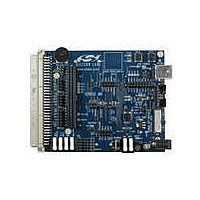1004-TCB1D434 Silicon Laboratories Inc, 1004-TCB1D434 Datasheet - Page 8

1004-TCB1D434
Manufacturer Part Number
1004-TCB1D434
Description
BOARD EVALUATION FOR SI1004
Manufacturer
Silicon Laboratories Inc
Type
Transceiver, ISMr
Specifications of 1004-TCB1D434
Mfg Application Notes
SI1000 Code Examples AppNote
Frequency
434MHz
Supply Voltage (min)
0.9 V
Product
RF Modules
Maximum Frequency
915 MHz
Output Power
13 dBm
Antenna
SMA
Supply Voltage (max)
3.6 V
For Use With/related Products
Si100x
Lead Free Status / RoHS Status
Lead free / RoHS Compliant
Lead Free Status / RoHS Status
Lead free / RoHS Compliant, Lead free / RoHS Compliant
Other names
336-1889
Si10xx-DK
5. Using the Keil Software 8051 Tools with the Silicon Laboratories IDE
To perform source-level debugging with the IDE, configure the Keil 8051 tools to generate an absolute object file in
the OMF-51 format with object extensions and debug records enabled. Build the OMF-51 absolute object file by
calling the Keil 8051 tools at the command line (e.g., batch file or make file) or by using the project manager built
into the IDE. The default configuration when using the Silicon Laboratories IDE project manager enables object
extension and debug record generation. Refer to "AN104: Integrating Keil 8051 Tools into the Silicon Labs IDE" in
the “SiLabs\MCU\Documentation\ApplicationNotes” directory on the CD-ROM for additional information on using the
Keil 8051 tools with the Silicon Laboratories IDE.
To build an absolute object file using the Silicon Laboratories IDE project manager, you must first create a project.
A project consists of a set of files, IDE configuration, debug views, and a target build configuration (list of files and
tool configurations used as input to the assembler, compiler, and linker when building an output object file).
The following sections illustrate the steps necessary to manually create a project with one or more source files,
build a program, and download it to the target in preparation for debugging. (The IDE will automatically create a
single-file project using the currently open and active source file if you select Build/Make Project before a project is
defined.)
5.1. Creating a New Project
1. Select Project
2. Select File
3. Right-click on “New Project” in the Project Window. Select Add files to project. Select files in the file browser
4. For each of the files in the Project Window that you want assembled, compiled and linked into the target build,
5. If a project contains a large number of files, the “Group” feature of the IDE can be used to organize. Right-click
5.2. Building and Downloading the Program for Debugging
1. Once all source files have been added to the target build, build the project by clicking on the Build/Make Project
2. Before connecting to the target device, several connection options may need to be set. Open the Connection
3. Click the Connect button in the toolbar or select Debug
4. Download the project to the target by clicking the Download Code button in the toolbar.
5. Save the project when finished with the debug session to preserve the current target build configuration, editor
8
recognized extension, such as .c, .h, or .asm, to enable color syntax highlighting.
and click Open. Continue adding files until all project files have been added.
right-click on the file name and select Add file to build. Each file will be assembled or compiled as appropriate
(based on file extension) and linked into the build of the absolute object file.
on “New Project” in the Project Window. Select Add Groups to project. Add pre-defined groups or add
customized groups. Right-click on the group name and choose Add file to group. Select files to be added.
Continue adding files until all project files have been added.
button in the toolbar or selecting Project
Note: After the project has been built the first time, the Build/Make Project command will only build the files that
have been changed since the previous build. To rebuild all files and project dependencies, click on the Rebuild
All button in the toolbar or select Project
Options window by selecting Options
adapter in the “Serial Adapter” section. Next, the correct “Debug Interface” must be selected. Si100x-Si101x
family devices use the Silicon Labs 2-wire (C2) debug interface. Once all the selections are made, click the OK
button to close the window.
Note: To enable automatic downloading if the program build is successful select Enable automatic connect/
download after build in the Project
the IDE will not attempt the download.
settings and the location of all open debug views. To save the project, select Project
the menu. Create a new name for the project and click on Save.
New File to open an editor window. Create your source file(s) and save the file(s) with a
New Project to open a new project and reset all configuration settings to default.
Target Build Configuration dialog. If errors occur during the build process,
Connection Options... in the IDE menu. First, select the appropriate
Build/Make Project from the menu.
Rebuild All from the menu.
Rev. 0.1
Connect from the menu to connect to the device.
Save Project As... from














